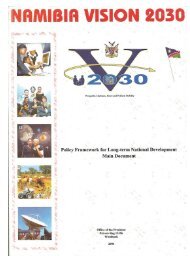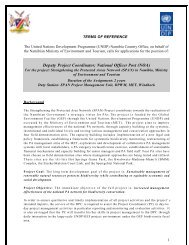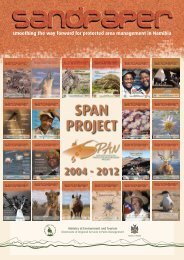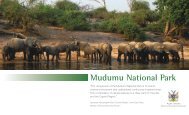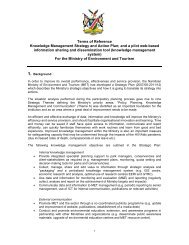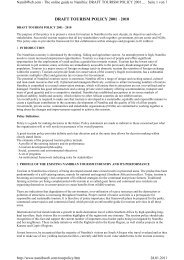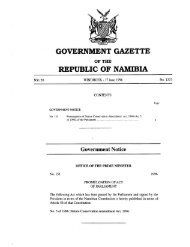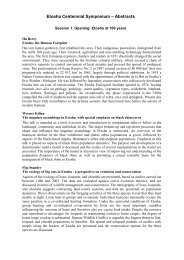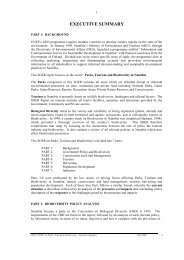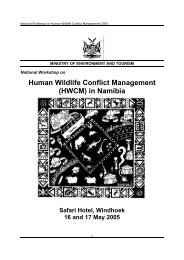Khaudum National Park - Ministry of Environment and Tourism
Khaudum National Park - Ministry of Environment and Tourism
Khaudum National Park - Ministry of Environment and Tourism
Create successful ePaper yourself
Turn your PDF publications into a flip-book with our unique Google optimized e-Paper software.
A long, varied history<br />
For millennia, the l<strong>and</strong> in <strong>and</strong> around where the <strong>Khaudum</strong> <strong>National</strong><br />
<strong>Park</strong> now st<strong>and</strong>s has been home to clans <strong>of</strong> hunter/gatherers.<br />
Yet with the disruption <strong>of</strong> traditional social systems, these<br />
groups inhabit a cultural hinterl<strong>and</strong> in conservancies <strong>and</strong> villages<br />
around the park that blends ancient <strong>and</strong> modern. Hunting within<br />
park boundaries is prohibited but conservation-driven community<br />
development is fuelled by the existence <strong>of</strong> the <strong>Khaudum</strong> <strong>National</strong><br />
<strong>Park</strong>. The absence <strong>of</strong> fences allows free movement <strong>of</strong> wildlife into<br />
locally owned l<strong>and</strong>, enhancing tourism potential <strong>and</strong> providing<br />
much-needed income to communities. The Gciriku Traditional Authority,<br />
Muduva Nyangana <strong>and</strong> George Mukoya conservancies will<br />
soon benefit directly from the two tourist camps within the park,<br />
Sikeretti Camp in the south <strong>and</strong> <strong>Khaudum</strong> Camp in the north. Entering<br />
an age <strong>of</strong> conservation where the protection <strong>of</strong> wildlife <strong>and</strong><br />
the support <strong>of</strong> rural communities goes h<strong>and</strong> in h<strong>and</strong>, these camps<br />
will be privately run in conjunction with the local conservancies.<br />
Off the beaten track<br />
The <strong>Khaudum</strong> <strong>National</strong> <strong>Park</strong> is all about adventure, <strong>and</strong> half <strong>of</strong> the<br />
adventure is simply getting there! The <strong>Ministry</strong> <strong>of</strong> <strong>Environment</strong><br />
<strong>and</strong> <strong>Tourism</strong> recommends a minimum <strong>of</strong> two vehicles per party,<br />
provisions for three days <strong>and</strong> 100 litres <strong>of</strong> water per vehicle per<br />
day. Travel is slow, heavy on fuel, <strong>and</strong> your 4x4 must be constantly<br />
engaged. Within the park, tracks tend to follow omurambas or link<br />
several waterholes together. There are two access points to <strong>Khaudum</strong><br />
<strong>National</strong> <strong>Park</strong>. From the south you can enter via the Tsumkwe<br />
road. From the north, use the Katere road. All roads, including the<br />
access points, require 4x4 vehicles, due to heavy, loose s<strong>and</strong>. There<br />
is no fuel available in the park. The closest fuel stations are Grootfontein<br />
(360 km from Sikeretti camp), Tsumkwe (only provides Diesel<br />
<strong>and</strong> Petrol 93 leaded type – 60 km from Sikeretti Camp), Rundu<br />
(170 km from <strong>Khaudum</strong> Camp) <strong>and</strong> Bagani/Divundu (150 km from<br />
<strong>Khaudum</strong> Camp). There is a state clinic on the Katere-<strong>Khaudum</strong><br />
camp road that is approximately 37 km from <strong>Khaudum</strong> Camp.



